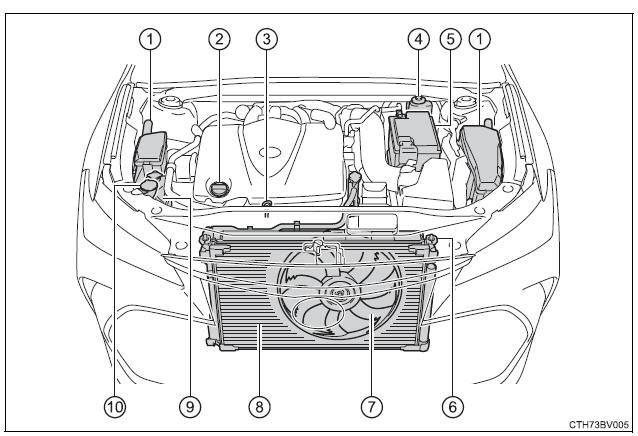
Engine oil
With the engine at operating temperature and turned off, check the oil level on the dipstick.
â– Checking the engine oil
1. Park the vehicle on level ground. After warming up the engine and turning it off, wait more than 5 minutes for the oil to drain back into the bottom of the engine.
2. Holding a rag under the end, pull the dipstick out.
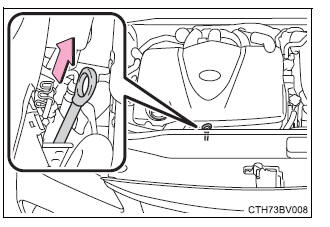
3. Wipe the dipstick clean.
4. Reinsert the dipstick fully.
5. Holding a rag under the end, pull the dipstick out and check the oil level.
The shape of the dipstick may differ depending on the type of vehicle or engine.
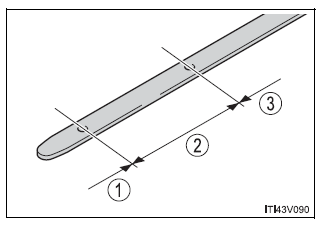
6. Wipe the dipstick and reinsert it fully.
â– Adding engine oil If the oil level is below or near the low level mark, add engine oil of the same type as that already in the engine.
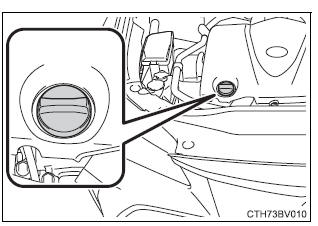
Make sure to check the oil type and prepare the items needed before adding oil.
| Oil quantity (Low → Full) | 1.9 qt. (1.8 L, 1.6 lmp. qt.) |
| Items | Clean funnel |
â– Engine oil consumption A certain amount of engine oil will be consumed while driving. In the following situations, oil consumption may increase, and engine oil may need to be refilled in between oil maintenance intervals.
| WARNING â– Used engine oil
|
| NOTICE â– To prevent serious engine damage Check the oil level on a regular basis. â– When replacing the engine oil
|
Engine coolant
The coolant level is satisfactory if it is between the "F" and "L" lines on the reservoir when the engine is cold.
If the level is on or below the "L" line, add coolant up to the "F" line.
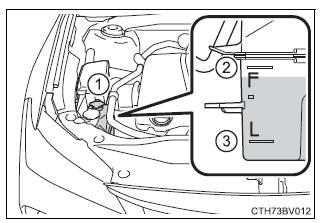
â– Coolant selection Only use "Toyota Super Long Life Coolant" or a similar high quality ethylene glycol based non-silicate, non-amine, non-nitrite, and non-borate coolant with long-life hybrid organic acid technology.
U.S.A.: "Toyota Super Long Life Coolant" is a mixture of 50% coolant and 50% deionized water. (Minimum temperature: -31ÂşF [-35ÂşC])
Canada: "Toyota Super Long Life Coolant" is a mixture of 55% coolant and 45% deionized water. (Minimum temperature: -44ÂşF [-42ÂşC]) For more details about engine coolant, contact your Toyota dealer.
â– If the coolant level drops within a short time of replenishing Visually check the radiator, hoses, engine coolant reservoir caps, drain cock and water pump.
If you cannot find a leak, have your Toyota dealer test the cap and check for leaks in the cooling system.
| WARNING â– When the engine is hot Do not remove the engine coolant reservoir cap or the radiator cap. The cooling system may be under pressure and may spray hot coolant if the cap is removed, causing serious injuries, such as burns. |
| NOTICE â– When adding coolant Coolant is neither plain water nor straight antifreeze. The correct mixture of water and antifreeze must be used to provide proper lubrication, corrosion protection and cooling. Be sure to read the antifreeze or coolant label. â– If you spill coolant Be sure to wash it off with water to prevent it from damaging parts or paint. |
Radiator and condenser
Check the radiator and condenser and clear away any foreign objects.
If either of the above parts is extremely dirty or you are not sure of their condition, have your vehicle inspected by your Toyota dealer.
| WARNING â– When the engine is hot Do not touch the radiator or condenser as they may be hot and cause serious injuries, such as burns. |
Brake fluid
â– Checking fluid level The brake fluid level should be between the "MAX" and "MIN" lines on the tank.
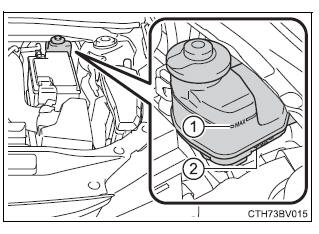
â– Adding fluid Make sure to check the fluid type and prepare the necessary item.
| Fluid type | SAE J1703 or FMVSS No.116 DOT 3 brake fluid SAE J1704 or FMVSS No.116 DOT 4 brake fluid |
| Item | Clean funnel |
â– Brake fluid can absorb moisture from the air Excess moisture in the brake fluid can cause a dangerous loss of braking efficiency.
Use only newly opened brake fluid.
| WARNING â– When filling the reservoir Take care as brake fluid can harm your hands and eyes and damage painted surfaces. If fluid gets on your hands or in your eyes, flush the affected area with clean water immediately. If you still experience discomfort, see a doctor. |
| NOTICE â– If the fluid level is low or high It is normal for the brake fluid level to go down slightly as the brake pads wear out or when the fluid level in the accumulator is high. If the reservoir needs frequent refilling, there may be a serious problem. |
Battery
Check the battery as follows.
â– Battery exterior Make sure that the battery terminals are not corroded and that there are no loose connections, cracks, or loose clamps.
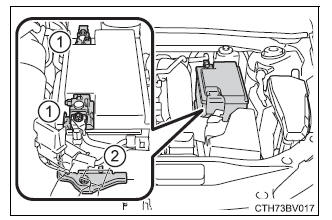
â– Before recharging When recharging, the battery produces hydrogen gas which is flammable and explosive. Therefore, observe the following before recharging:
â– After recharging/reconnecting the battery
If the system will not start even after multiple attempts, contact your Toyota dealer.
| WARNING â– Chemicals in the battery Batteries contain poisonous and corrosive sulfuric acid and may produce hydrogen gas which is flammable and explosive. To reduce the risk of death or serious injury, take the following precautions while working on or near the battery:
â– Where to safely charge the battery Always charge the battery in an open area. Do not charge the battery in a garage or closed room where there is insufficient ventilation. â– Emergency measures regarding electrolyte
â– When disconnecting the battery Do not disconnect the negative (-) terminal on the body side. The disconnected negative (-) terminal may touch the positive (+) terminal, which may cause a short and result in death or serious injury. |
| NOTICE â– When recharging the battery Never recharge the battery while the engine is running. Also, be sure all accessories are turned off. |
Washer fluid
Add washer fluid in the following situations:
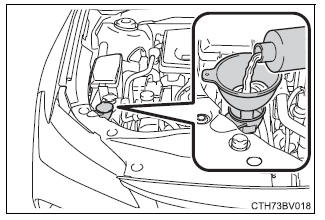
| WARNING â– When adding washer fluid Do not add washer fluid when the engine is hot or running as washer fluid contains alcohol and may catch fire if spilled on the engine, etc. |
| NOTICE â– Do not use any fluid other than washer fluid Do not use soapy water or engine antifreeze instead of washer fluid. Doing so may cause streaking on the vehicle's painted surfaces, as well as damaging the pump leading to problems of the washer fluid not spraying. â– Diluting washer fluid Dilute washer fluid with water as necessary. Refer to the freezing temperatures listed on the label of the washer fluid bottle. |
Toyota Avalon (XX50) 2019-2022 Service & Repair Manual > Navigation System(for Gasoline Model): Reverse Signal Circuit. Route cannot be Calculated. Satellite Radio Broadcast cannot be Received
Reverse Signal Circuit DESCRIPTION The radio and display receiver assembly receives a reverse signal from the BKUP LP relay. WIRING DIAGRAM PROCEDURE 1. CHECK BACK-UP LIGHT (a) Move the shift lever to R and check if the back-up lights come on. OK: The back-up lights come on. NG GO TO LIGHTING SYSTEM ...